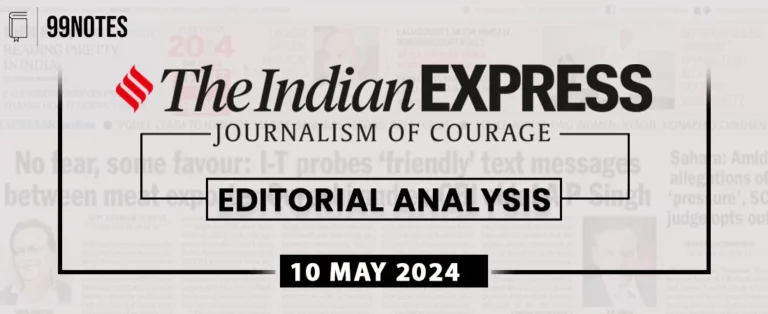18 May 2024 : Indian Express Editorial Analysis
1. HURDLES ON PATH TO GREEN
| Topic: GS2 – Governance – Government policies – Interventions for development in various sectors
GS3 – Environment – Environment pollution and degradation |
| Context: |
|
India’s Green Energy Initiatives:
- In response to these challenges, the Indian government has launched several initiatives to support a shift towards green energy.
- Key programs include the Production Linked Incentive (PLI) scheme aimed at boosting the manufacturing of solar modules, viability gap funding for offshore wind and battery storage projects, and the Faster Adoption & Manufacturing of Electric Vehicles (FAME) scheme.
- Additionally, the National Green Hydrogen Mission and amendments to the Energy Conservation Act are steps towards promoting green technologies.
- Although not yet mandatory, some entities are proactively adopting these technologies, driven by stakeholder demands and the anticipated regulatory landscape.
Transition Risks in Green Technology Adoption:
- Entities transitioning to green technologies face various risks, including policy, regulatory, technology, market, reputation, and legal challenges.
- Technological risk is particularly significant, as the immediate adoption of new green technologies can be complex and costly.
- This transition necessitates considerable investments and strategic planning to mitigate these risks effectively.
The Role of Renewable Energy in Reducing Carbon Emissions:
- Fossil fuel-based power is a major source of carbon emissions in India. To meet the government’s climate target of enhancing non-fossil power to 50 percent by 2030, various schemes have been launched to boost renewable energy (RE).
- Projections by ICRA indicate that India’s share of non-fossil fuel-based installed capacity could rise from 41 percent in 2022-23 to 59 percent by 2029-30.
- However, achieving this transition will require significant investments, estimated at Rs 11-12 lakh crore for RE power and an additional Rs 5-6 lakh crore for transmission infrastructure and storage capabilities.
Addressing Intermittency and Hard-to-Abate Sectors:
- Ensuring a round-the-clock supply of energy from renewable sources is crucial, given their intermittent nature.
- This can be addressed through hybrid RE projects (combining wind and solar) and advanced energy storage systems.
- For hard-to-abate sectors like steel and cement, the government must explore more effective carbon sequestration methods.
- Carbon capture, utilization, and storage (CCUS) technologies will be essential, particularly in the cement industry, where producing one tonne of cement releases an equivalent amount of carbon dioxide.
- Niti Aayog’s report estimates that the cement sector will require two million tonnes per annum of CCUS capacity by 2030, with a capital cost of Rs 1,600-1,800 crore.
Reducing Emissions in the Steel Industry:
- India’s steel industry predominantly uses coal due to the abundance of virgin iron ore and the lack of domestic scrap. This reliance on coal results in high emissions.
- However, in line with India’s 2070 net-zero target and international carbon tax policies, domestic steelmakers are focusing on reducing their carbon footprint by 25-30 percent through various technological interventions by 2030.
Green Hydrogen: A Promising Solution:
- The National Green Hydrogen Mission is a significant step towards using green hydrogen in refining, chemical, and fertilizer sectors, as well as in transportation.
- The capital expenditure for these initiatives is projected to be about Rs 8-9 lakh crore.
- Several Indian entities have already launched pilot projects or announced plans to establish production facilities for green hydrogen and green ammonia.
Government Support for Technology Transition:
- While many entities in high-carbon-emitting sectors are voluntarily taking steps to become more environmentally friendly, government support remains critical to accelerate this technological transition.
- Such support could include policy interventions, subsidies, duty exemptions, or tax benefits.
- These measures will likely form a crucial part of the policy agenda following the elections, ensuring that India can meet its ambitious climate targets and support sustainable economic growth.
| What is the Current Solar Capacity in India? |
|
| PYQ: Access to affordable, reliable, sustainable and modern energy is the sine qua non to achieve Sustainable Development Goals (SDGs). Comment on the progress made in India in this regard. (150 words/10m) (UPSC CSE (M) GS-3 2018) |
| Practice Question: Discuss the recent heatwave’s impact on the urgency to address climate change and evaluate India’s efforts and challenges in transitioning to green energy, particularly in high carbon-emitting sectors. (250 words/15 m) |
2. Social justice with growth
| Topic: GS2 – Governance – Government policies – Interventions for development in various sectors GS1 – Indian Society |
| Context: |
|
Legal and Economic Opposition:
Legal Concerns:
- The primary legal argument against raising the reservation cap is that it violates the Constitution’s provisions by exceeding the 50 percent limit set by the Supreme Court.
- This cap was established to balance affirmative action with the principle of equality, and exceeding it could lead to legal challenges and potential judicial interventions.
Economic Concerns:
- Economically, critics argue that increasing reservations compromises talent, skill, and merit, potentially leading to poorer economic outcomes.
- They believe that reserving more positions for historically oppressed castes could reduce the overall efficiency and competitiveness of the workforce, thereby negatively impacting economic growth and development.
Empirical Evidence and Natural Experiments:
- However, the economic argument against increased reservations can be refuted with empirical evidence.
- “Natural experiments,” a robust research methodology used by economists, can provide insights into the real-world effects of policy changes.
- For instance, Nobel laureate David Card’s study on the impact of raising minimum wages used a natural experiment by comparing two neighboring areas with different wage policies.
The Tamil Nadu Experiment:
Higher Reservation in Tamil Nadu:
- Tamil Nadu (TN) offers a natural experiment to study the economic impact of raising the reservation cap beyond 50 percent.
- In 1990, TN increased its reservation quota for OBCs, SCs, and STs to 69 percent.
- Despite the 1992 Supreme Court ruling imposing a 50 percent ceiling on reservations, TN managed to secure its higher quota by placing the reservation bill under the Ninth Schedule of the Constitution, thereby exempting it from judicial review.
Economic Outcomes in Tamil Nadu:
- Over the past three decades, TN’s economic performance provides a clear counter-argument to critics who claim that higher reservations hinder economic development.
- Between 1993 and 2023, TN had the second-highest growth in per capita GDP among major Indian states, trailing only Karnataka.
- This suggests that higher reservations have not impeded economic growth.
- Moreover, TN saw a significant increase in the number of factories, doubling from 1993 to 2023, which was the second highest increase after Gujarat.
- In contrast, Bihar experienced a decline in the number of factories.
- TN also led in investments by medium and small private sector enterprises and had the second-highest production levels after Maharashtra.
- Employment data further supports TN’s economic success, as the state employs the highest number of workers among its peers and offers the highest wages for non-agricultural labourers, nearly 70 percent higher than in Maharashtra.
- Additionally, TN’s significant contributions to India’s electronics production and smartphone exports highlight its robust industrial growth, particularly in districts like Kanchipuram, where a substantial portion of the population belongs to the Dalit community.
Debunking the Myths of Economic Downfall:
Misconceptions about Reservation and Merit
- The evidence from TN demonstrates that exceeding the 50 percent reservation cap does not dilute merit or hinder economic development.
- Contrary to fears, it has not deterred investors, entrepreneurs, or workers. Instead, it promotes inclusive economic growth, a goal that many nations strive to achieve.
Broader Implications for India
- The experience of TN suggests that fears about economic slowdowns due to increased affirmative action are unfounded.
- While one can debate the effectiveness and sufficiency of reservations as a tool for social justice, the notion that higher reservations will impede economic progress is not supported by empirical evidence.
Conclusion:
- Raising the reservation cap for OBCs, SCs, and STs need not hinder India’s economic progress.
- The Tamil Nadu example illustrates that it is possible to achieve substantial economic growth and development while implementing higher reservations.
- As India continues to strive for inclusive growth, policies promoting affirmative action should be seen as complementary to economic development rather than contradictory to it.
| Constitution and Reservation |
|
| PYQ: “The reservation of seats for women in the institutions of local self- government has had a limited impact on the patriarchal character of the Indian Political Process.” Comment. (250 words/15m) (UPSC CSE (M) GS-2 2019) |
| Practice Question: Discuss the implications of raising the reservation cap beyond 50 percent for OBCs, SCs, and STs in India, considering both the legal and economic perspectives. Use the example of Tamil Nadu to support your analysis. (250 words/15 m) |





